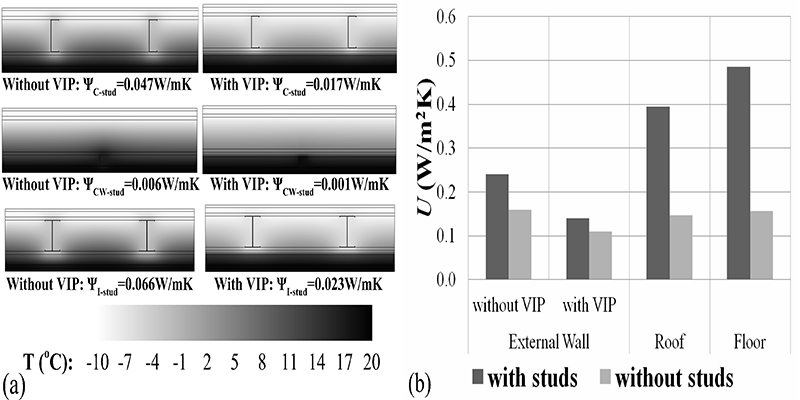Downloads
DOI:
https://doi.org/10.7480/jfde.2016.1-2.1097Keywords:
VIP, Thermal Bridges, Lightweight Building, Thermal transmittanceAbstract
This paper addresses the thermal bridges issues of a two storey lightweight steel framed envelope in which the VIPs are placed in an inner “protected” layer of the external walls. This configuration provides “protection” for the VIPs, allows flexibility in installation of façade elements and at the same time permits interventions and modifications (e.g. drilling, installation of appliances) on the internal side of the wall. The envelope is extensively analyzed in terms of all the different types of thermal bridges utilizing commercial computational tools and standardized methodologies and their effect on the overall thermal performance is evaluated. A total improvement of 33% on the heat transfer coefficient of the building is estimated. Results indicate the junctions between the external and internal walls, the external walls and the ceiling, the internal walls and the roof and the internal walls and the floor, respectively, as the most crucial thermal bridges. Different design modifications and solutions are assumed in order to further reduce the impact of the most crucial thermal bridges. The implementation of the modifications resulted to a further reduction of the overall thermal losses by 27.5%, leading to an overall thermal loss reduction by 60.5% when compared to the reference building.
How to Cite
Published
Issue
Section
License
Copyright (c) 2016 Dimos A. Kontogeorgos, Ioannis A. Atsonios, Ioannis D. Mandilaras, Maria A. Founti

This work is licensed under a Creative Commons Attribution 4.0 International License.
Authors or their institutions retain copyright to their publications without restrictions.
References
Alam, M., Singh, H., & Limbachiya, M.C. (2011). Vacuum Insulation Panels (VIPs) for building industry - A review of the contemporary developments and future directions. Applied Energy, 88(11), 3592-3602. doi:10.1016/j.apenergy.2011.04.040.
ANSYS CFX (2009). ANSYS CFX-Solver Theory Guide. Canonsburg, ANSYS, Inc.
Boafo, F.E., Chen, Z., Li, C., Li, B., & Xu, T. (2014). Structure of vacuum insulation panel in building system. Energy and Buildings, 85, 644-653. doi:10.1016/j.enbuild.2014.06.055.
Capozzoli, A., Gorrino, A., & Corrado, V. (2013). A building thermal bridges sensitivity analysis. Applied Energy, 107, 229-243. doi:10.1016/j.apenergy.2013.02.045.
De Angelis, E., & Serra, E. (2014). Light steel-frame walls: thermal insulation performances and thermal bridges. Energy Procedia, 45, 362- 371. doi:10.1016/j.egypro.2014.01.039.
EN ISO 10211 (2007). Thermal bridges in building construction – Heat flows and surface temperatures - Detailed calculations (ISO 10211:2007). Brussels, Management Centre.
EN ISO 6946 (2007). Building components and building elements – Thermal resistance and thermal transmittance – Calculation method.
Evola, G., Margani, G., & Marletta, L. (2011). Energy and cost evaluation of thermal bridge correction in Mediterranean climate. Energy and Buildings, 43(9), 2385-2393. doi:10.1016/j.enbuild.2011.05.028.
Kalnaes, S.E., & Jelle, B.P. (2014). Vacuum insulation panel products: A state-of-the-art review and future research pathways. Applied Energy, 116, 355-375. doi:10.1016/j.apenergy.2013.11.032.
Mandilaras, I., Atsonios, I., Zannis, G., & Founti, M. (2014). Thermal performance of a building envelope incorporating ETICS with vacuum insulation panels and EPS. Energy and Buildings, 85, 654-665. doi:10.1016/j.enbuild.2014.06.053.
Simmler, H., & Brunner, S. (2005). Vacuum insulation panels for building application: Basic properties, aging mechanisms and service life. Energy and Buildings, 37(11), 1122-1131. doi:10.1016/j.enbuild.2005.06.015.
Theodosiou, T.G., Papadopoulos, A.M. (2008). The impact of thermal bridges on the energy demand of buildings with double brick wall constructions. Energy and Buildings, 40(11), 2083-2089. doi:10.1016/j.enbuild.2008.06.006.
U.S. Energy Information Administration (EIA) (2015). Monthly Energy Review. Washington, U.S. Energy Information Administration.
Zalewski, L., Lassue, S., Rousse, D., & Boukhalfa, K. (2010). Experimental and numerical characterization of thermal bridges in prefabricated building walls. Energy Conversion and Management, 51(12), 2869-2877. doi:10.1016/j.enconman.2010.06.026.
